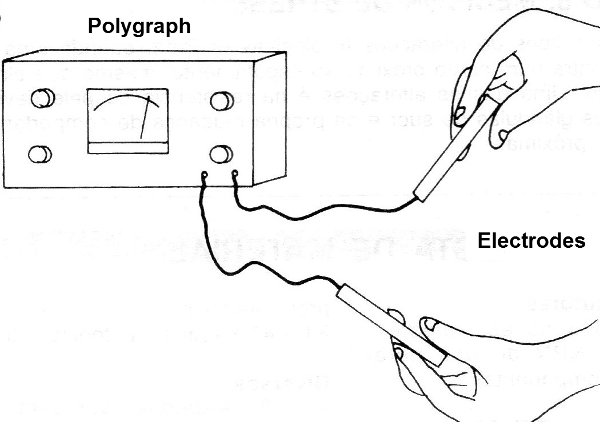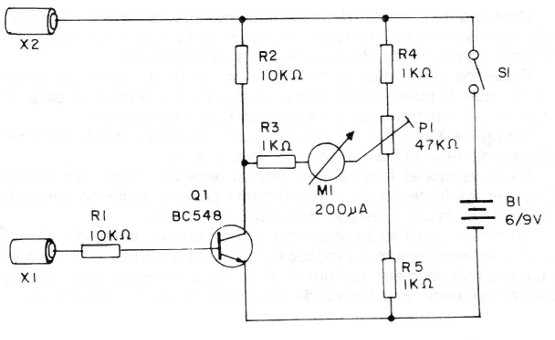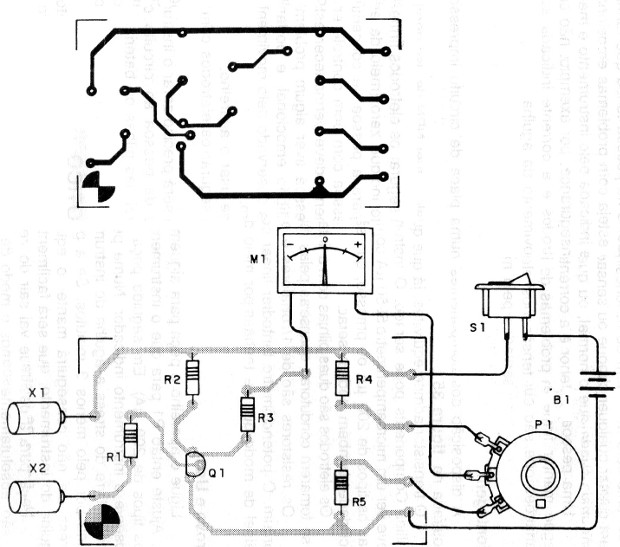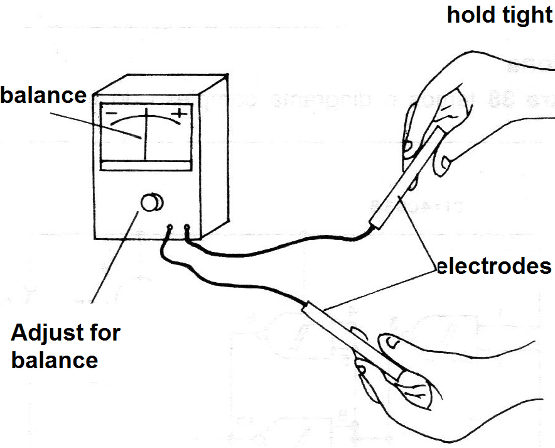One way to detect this state of stress or even tension is to monitor the resistance of the skin, which can easily be done with the help of the apparatus we describe.
We can say that it is a very simple and sensitive polygraph, which also serves as a lie detector and to accuse acupuncture points if the electrodes are modified.
In Figure 1 we have the way a polygraph is used to detect variations in a person's skin resistance.

These variations can either indicate emotional tensions associated to a lie or can help in concentration or even to measure the state of tension or stress.
The circuit basically consists of a sensitive Wheatstone bridge with a common transistor and the indication of skin resistance being provided by a common micro-meter.
The power can be done with 4 small batteries or a battery of 9 V and its consumption is very low.
How it works
In Figure 2 we have the complete Stress Meter diagram.

An indicator instrument, preferably of the type containing the zero in the center of the scale (as in the previous design) is placed on a Wheatstone bridge in order to monitor its equilibrium.
One of the branches of the bridge contains a common bipolar transistor which works as an amplifier element for the current to be circulated by the testing electrodes.
These electrodes are safe for the person who wants to test their stress, so that a current circulates through their skin and their body.
This current is of the order of millionths of amp, very weak, therefore, to cause any damage or sensation. One feels absolutely nothing.
However, the intensity of this current will depend on the resistance of the person's skin and the way it holds the electrodes, which makes it possible to assess the stress state by its value. For battery power, the current will be in the order of one millionths of an amp, which is insufficient to cause any shock or sensation.
A tense person who has a sweaty hand more than normal, or who has emotional problems, has a lower resistance and the current indicated by the instrument is greater.
A person with problems of insecurity, for example, cannot keep the tension in the electrodes firm and the indicated current undergoes variations which are observed by the movement of the needle.
Assembly
The arrangement of the components on a printed circuit board is shown in Figure 3.

The transistor admits equivalent, since any NPN of general use can be used. The M1 instrument should preferably be a 50-0-50 uA microammeter with zero at the center of the scale, but the 200 uA or more types which are easily found can also be used.
The electrodes are two spent batteries with the outer paint scraped so as to become conductive when held by the tested person's hands.
The resistors are 1/3 W or larger and the switch S1 is of the common type. The potentiometer can either be linear or log and will be attached to the dashboard so that it can be accessed by means of an external button.
Test and Use
Turn on the appliance and have someone hold the electrodes firmly. Then set P1 so that the instrument indicates zero (half of the range in 200 uA types). Then have the person focus and observe the indicating instrument.
In a person with good emotional control and stress free, the instrument needle should remain stationary for at least 3 minutes. If the person has a stress problem, he or she will not be able to maintain the emotional balance, and therefore the voltage on the electrodes, which will be easily observed by the needle movement of the instrument, which will come out of zero.
In Figure 4 we illustrate how to use the apparatus.

Ask the person to focus and hold the electrodes with an absolutely constant tension.
Whenever you test with someone, you will need to reset the instrument, both to adapt the person's characteristics to the circuit and to compensate for the natural wear of the batteries or battery.
Semiconductors:
Q1 - BC548 or equivalent general purpose NPN transistor
Resistors: (1 / 3W, 5%)
R1, R2 - 10 k ohm - brown, black, orange
R3, R4, R5 - 1k ohm - brown, black, red
P1 - 47 k ohm - potentiometer
Miscellaneous:
X1, X2 - electrodes - see text
S1 - Single switch
M1 - microammeter - see text
B1 - 6/9 V - 4 batteries or battery



